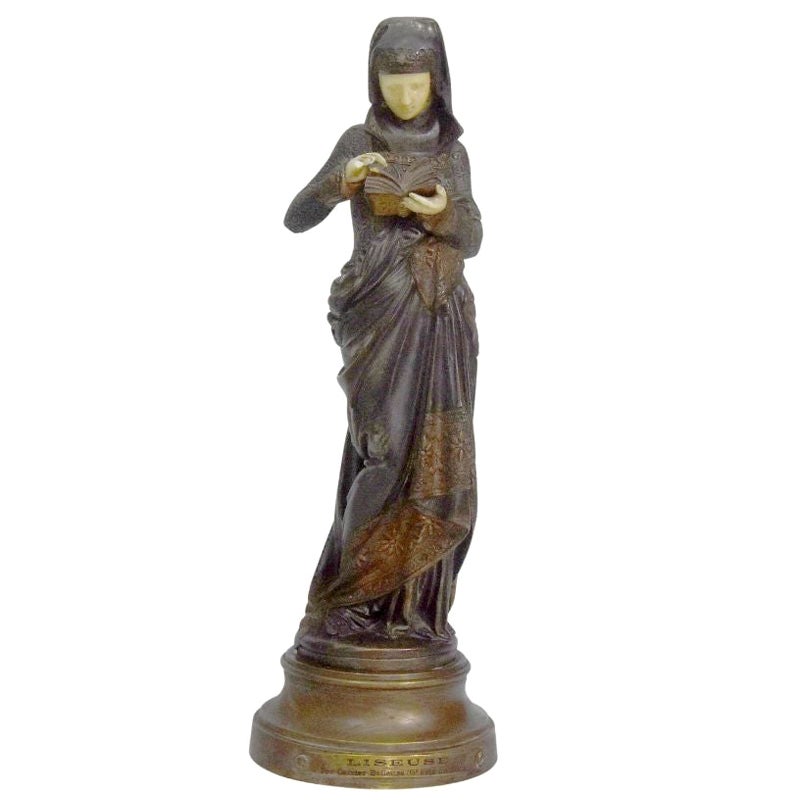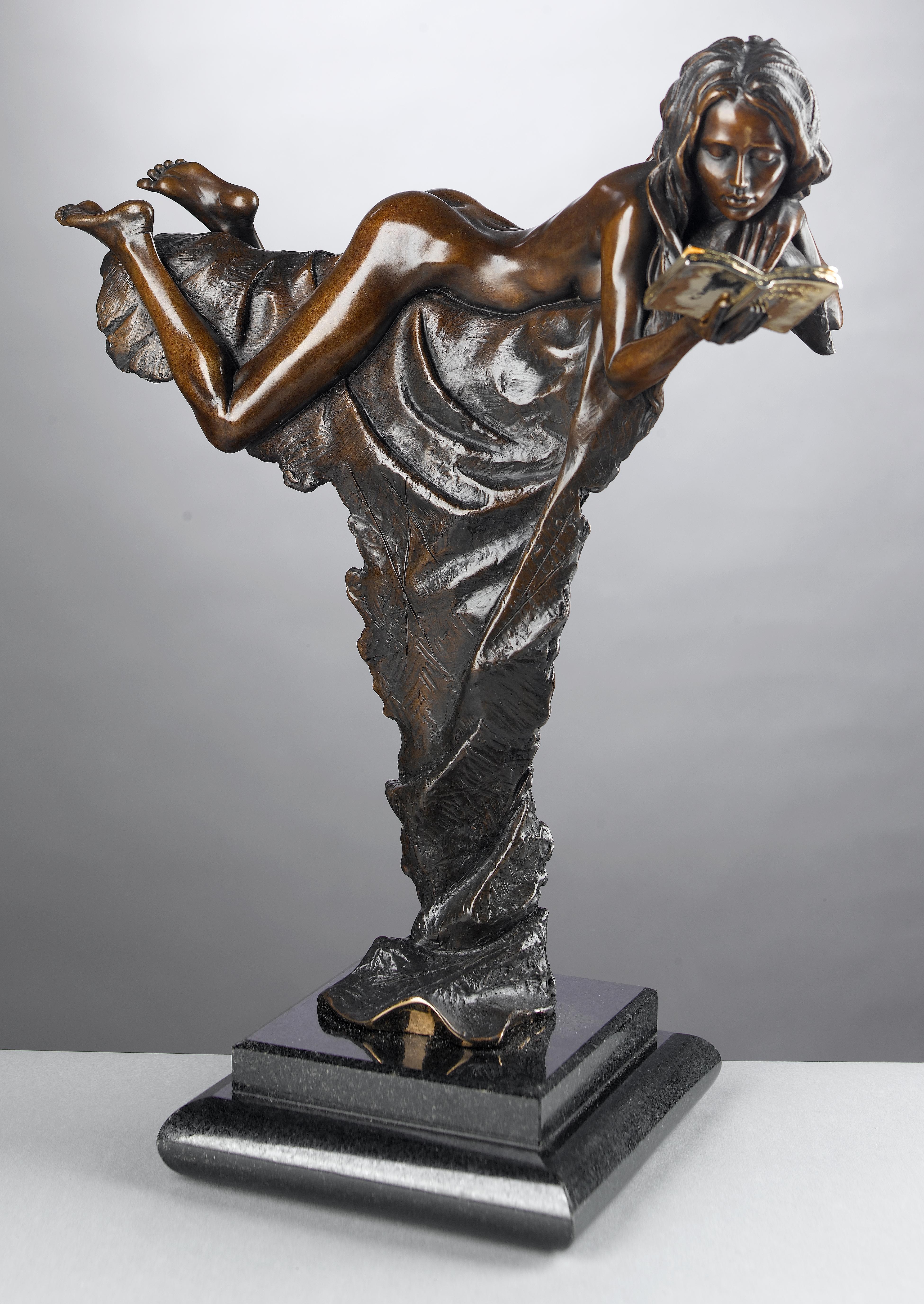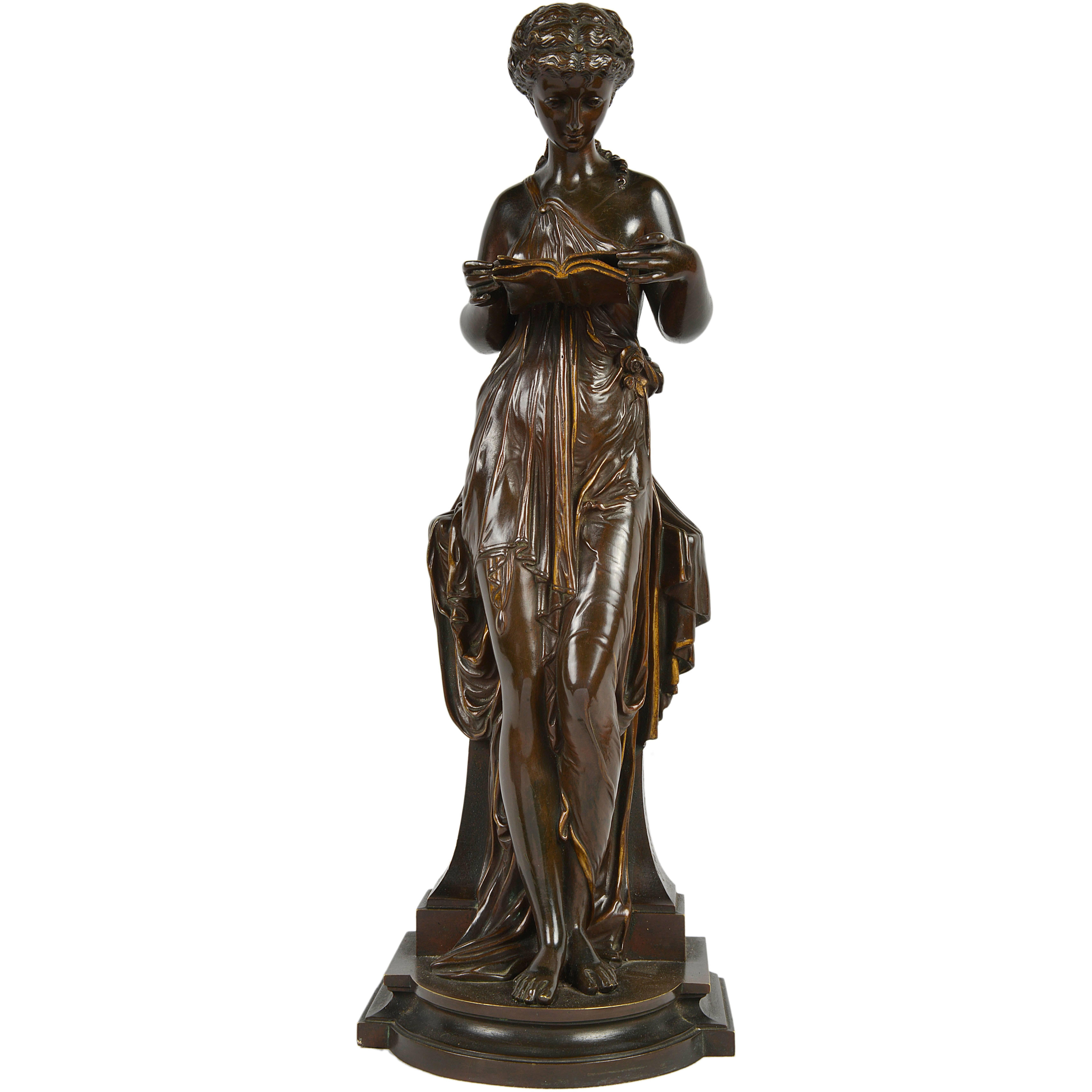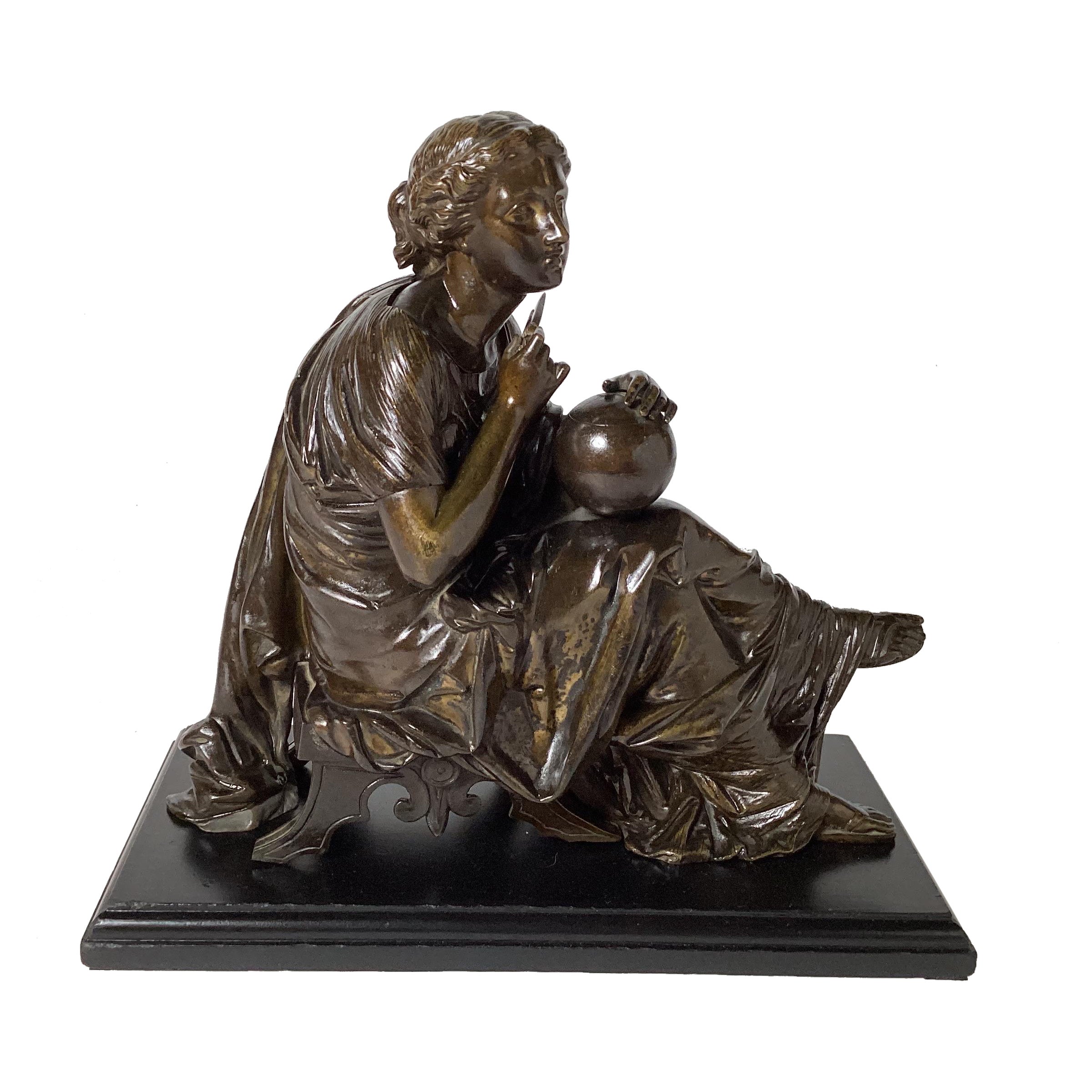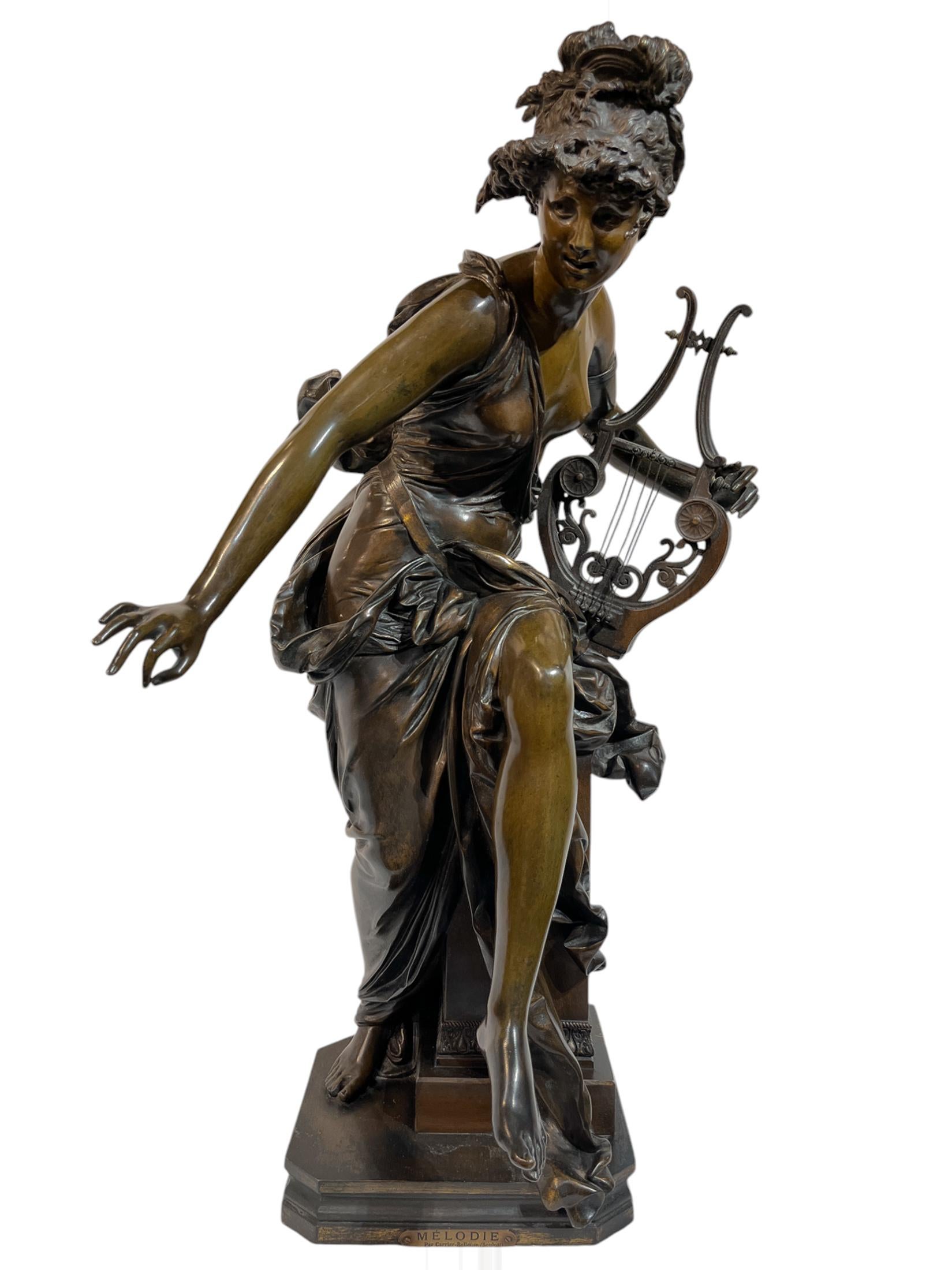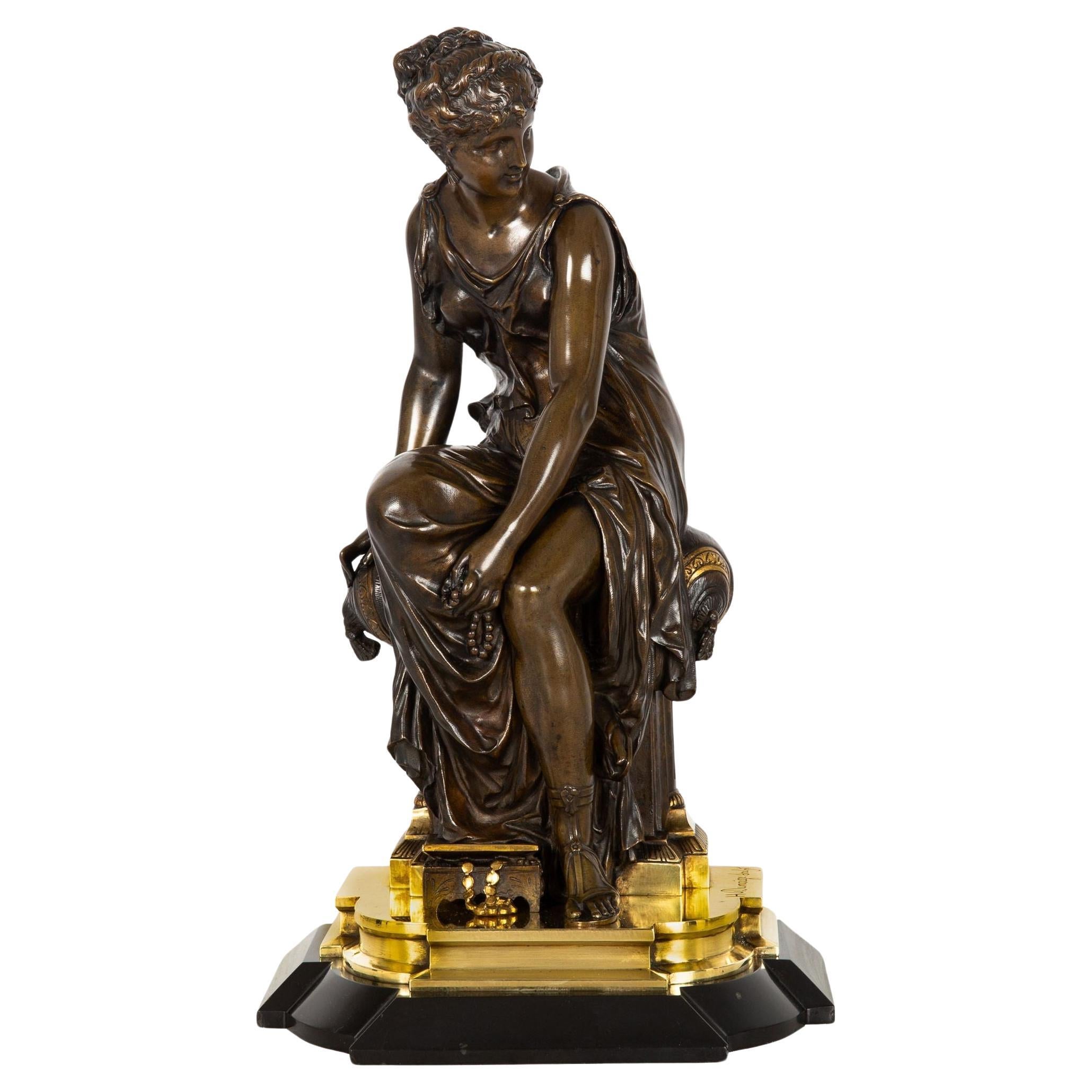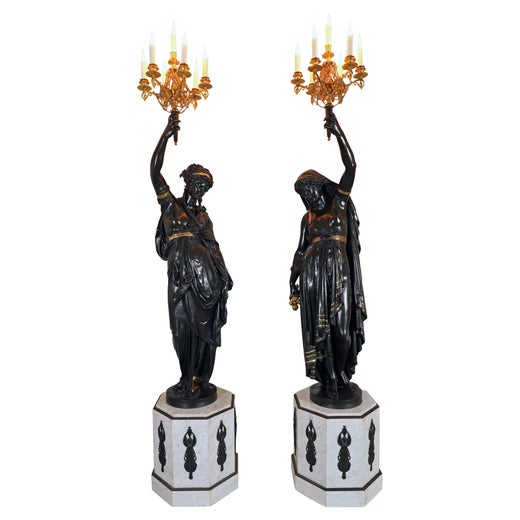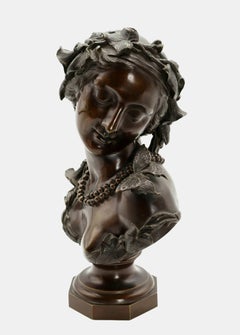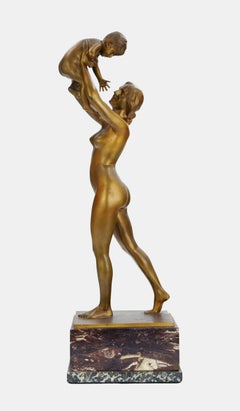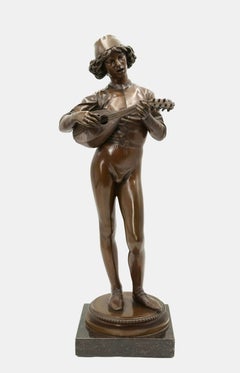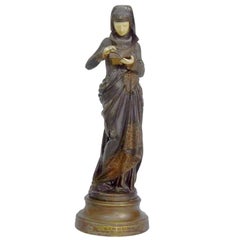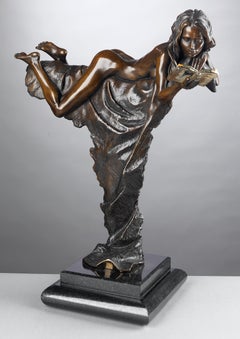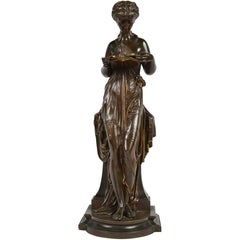Items Similar to Reading Woman / - The golden glow of imagination -
Want more images or videos?
Request additional images or videos from the seller
1 of 10
Albert-Ernest Carrier-BelleuseReading Woman / - The golden glow of imagination -c. 1880
c. 1880
$2,312.04
$2,890.0520% Off
£1,710.62
£2,138.2720% Off
€1,920
€2,40020% Off
CA$3,196.80
CA$3,99620% Off
A$3,509.69
A$4,387.1120% Off
CHF 1,831.01
CHF 2,288.7720% Off
MX$42,472.16
MX$53,090.2020% Off
NOK 22,948.91
NOK 28,686.1420% Off
SEK 21,623.91
SEK 27,029.8920% Off
DKK 14,618.93
DKK 18,273.6720% Off
About the Item
Albert-Ernest Carrier-Belleuse (1824 Anizy-le-Château - 1887 Sèvres), Reading Woman, around 1880. Polished bronze mounted on a cast base. 33 cm (total height) x 9 cm (length) x 9 cm (depth), weight 2.97 kg. Signed on the plinth “A.[lbert-Ernst] CARRIER.BELLEUSE], titled ‘LISEUSE’ on the base plate and inscribed ‘Par Carrier-Belleuse (Grand Prix de Salon)’.
- The front edge of the plinth with a small bumped area, slight traces of oxidation in the breast area, somewhat rubbed in places, overall in very good condition for its age
- The golden glow of imagination -
Albert-Ernest Carrier-Belleuse takes us back to the time of the Très Riches Heures, the Book of Hours of the Duke of Berry, created by the Limbourg brothers between 1485 and 1489. The reading woman seems to have stepped directly out of the world of the Book of Hours, reflecting on the act of reading itself. Her gown, decorated with extremely rich brocade embroidery, which requires the greatest precision in the bronze casting, identifies her as an elegant court lady. She is engrossed in reading a book, which may be a Book of Hours, as indicated by its richly decorated cover and format. While the lady holds the book with one hand and the open pages with her thumb, the fingers of the other hand are already turning the next page, thus illustrating the process of reading. If her face radiates a calm, almost motionless beauty, the cascading folds convey the inner movement to the outside. Like a saintly figure of the time, she has gathered her outer garment with her forearm, creating elegant drapery that also dramatizes the figure.
Carrier-Belleuse experimented with galvanic processes to silver and gild the surfaces of bronze sculptures. The Woman Reading, for which the artist was awarded the Grand Prix of the Paris Salon, is an outstanding example of this innovative technique. The golden appearance evokes the lost "sacred" time visualized by the reading woman. At the same time, the pictorial representation of reading opens up the realm of the imagination.
About the artist
After an apprenticeship as a chaser and goldsmith in Paris, Albert-Ernest Carrier-Belleuse began studying at the Ecole des Beaux-Arts under Pierre-Jean David d'Angers in 1840, but soon turned his back on academic art and transferred to the Petite École, which became the École nationale des arts décoratifs in 1877. In 1848, he moved to England and worked as a designer for the famous Herbert Minton porcelain and faience factory in Stoke-upon-Trent. He also designed for Wedgewood and Copeland, the cast iron company Coalbrookdale, and the furniture company Graham & Jackson. Even after returning to Paris in 1855, he continued to provide models for British manufacturers throughout his artistic career.
From 1857, he was a regular exhibitor at the Paris Salon and quickly became a sought-after artist. Napoleon III acquired the marble statue "Bacchante", presented in 1863, for the Tuileries Gardens (now in the Musée d'Orsay) and praised Carrier-Belleuse as "notre Clodion", referring to the most admired sculptor of the 18th century in France, Claude Michel gen. Clodion (1738-1814). The emperor's appreciation led to further state purchases. In 1867, the "Messiah" from the Salon, which had been awarded the Medal of Honor, was purchased for the St-Vincent-de-Paul Church in Paris, which also earned the artist the Cross of the Legion of Honor. "The Sleeping Hebe of 1869 was even commissioned by the state and is now in the Musée d'Orsay.
Carrier-Belleuse also created numerous portrait busts of contemporary and historical figures. He portrayed Napoléon III, Eugène Delacroix, Honoré Daumier, Théophile Gautier and his great idol Jean-Antoine Houdon, among others. His oeuvre also includes monumental memorials such as the "Maréchal Masséna" in Nice (1869) and the equestrian monument to the unification of Wallachia, Transylvania and Moldavia in Bucharest (1876).
In 1871, Carrier-Belleuse and Auguste Rodin fled from the Paris Commune to Brussels, where they created a frieze for the newly built stock exchange under his direction. After his return to Paris, one of his most important artistic activities was undoubtedly his creations for the New Opera of Charles Garnier, with whom he was friends, as well as with Jean-Baptiste Carpeaux. From 1875 until his death in 1887, Carrier-Belleuse was artistic director of the Sèvres porcelain factory, which flourished under his leadership. Auguste Rodin also worked for Carrier-Belleuse in Sèvres from 1877 to 1883, and Rodin created a terracotta bust of him in 1882.
In addition to his artistic innovations, which opened academic classicism to a new naturalistic sensuality, Carrier-Belleuse also developed technical innovations. He experimented with galvanic methods of finishing bronze sculptures.
In 1885, an incurable eye disease gradually blinded him. In the same year, the artist, who had been named a Knight of the Legion of Honor in 1867, was made an Officer of the Legion of Honor.
Albert-Ernest Carrier-Belleuse signed his works "A. Carrier" and from about 1868 "A. Carrier-Belleuse".
GERMAN VERSION
Albert-Ernest Carrier-Belleuse (1824 Anizy-le-Château - 1887 Sèvres), Lesende, um 1880. Polierte Bronze auf gegossenem Sockel montiert. 33 cm (Gesamthöhe) x 9 cm (Länge) x 9 cm (Tiefe), Gewicht 2,97 kg. Auf der Plinthe mit „A.[lbert-Ernst] CARRIER.BELLEUSE] signiert, auf dem Sockelschildchen als „LISEUSE“ betitelt und mit „Par Carrier-Belleuse (Grand Prix de Salon)“ bezeichnet.
- vorderer Rand der Plinthe mit kleiner bestoßener Stelle, leichte Oxidationsspuren im Brustbereich, stellenweise etwas berieben, insgesamt in einem altersgemäß sehr guten Zustand
- Der goldene Glanz der Imagination -
Albert-Ernest Carrier-Belleuse versetzt uns in die Zeit des „Très Riches Heures“, das zwischen 1485 und 1489 von den Brüdern Limburg geschaffene Stundenbuch des Herzogs von Berry. Seine Lesende scheint unmittelbar der Welt des Stundenbuchs entstiegen zu sein, wobei sie selbst auf den Akt des Lesens reflektiert. Ihr mit überaus reicher Brokatstickerei verziertes Gewand, dass dem Bronzeguss höchste Präzision abverlangt, weist sie als elegante höfische Dame aus. Sie ist in die Lektüre eines Buches vertieft, bei dem es sich ebenfalls um ein Stundenbuch handelt mag, worauf der reich ornamentierte Einband und das Format hinweisen. Während die Dame mit der einen Hand das Buch und mit dem Daumen die aufgeschlagenen Seiten hält, blättern die Finger der anderen Hand bereits die nächste Seite um, so dass der Prozess des Lesens veranschaulicht wird. Strahlt ihr Gesicht eine stille nahezu unbewegte Schönheit aus, so trägt der kaskadenartige Faltenwurf die inneren Bewegtheit nach außen. Wie eine Heiligenfigur der Zeit hat sie ihr Obergewand mit dem Unterarm zusammengerafft, wodurch elegante Faltenwürfe entstehen, die die Figur zugleich dramatisieren.
Carrier-Belleuse hat mit galvanischen Methoden experimentiert, die Oberflächen der Bronzeplastiken zu versilbern und zu vergolden. Die Lesende, für die der Künstler mit dem Grand Prix des Pariser Salons ausgezeichnet wurde, ist ein herausragendes Beispiel für diese innovative Technik. Die goldene Erscheinung gemahnt an den Goldgrund der untergegangenen ‚heiligen‘ Zeit, die von der Lesende vergegenwärtigt wird. Zugleich eröffnet uns die bildliche Darstellung des Lesens das Reich der Imagination.
zum Künstler
Nach einer Lehre als Ziseleur und Goldschmied in Paris nahm Albert-Ernest Carrier-Belleuse 1840 ein Studium an der Ecole des Beaux-Arts unter Pierre-Jean David d'Angers auf, kehrte der akademischen Kunst aber bald den Rücken und wechselte an die „Petite École“, aus der 1877 die „École nationale des arts décoratifs“ hervorging. 1848 zog er nach England und war als Entwerfer für die berühmte Porzellan- und Fayencefabrik Herbert Minton in Stoke-upon-Trent beschäftigt. Zudem erstellt er Entwürfe für Wedgewood und Copeland, für den Gusseisenhersteller Coalbrookdale und die Möbelmanufaktur Graham & Jackson. Auch nachdem er 1855 nach Paris zurückgekehrt war, lieferte er über sein ganzes künstlerisches Wirken hinweg Modelle für britische Manufakturen.
In Paris beschickt er ab 1857 kontinuierlich den Pariser Salon und wurde schnell zum gefragten Künstler. Napoleon III. erwarb die 1863 präsentierte Marmorstatue „Bacchante“ für die Gärten der Tuilerien (heute im Musée d´Orsay) und rühmte Carrier-Belleuse als „notre Clodion“, womit er sich auf den in Frankreich am meisten bewunderten Bildhauer des 18. Jahrhunderts, Claude Michel gen. Clodion (1738-1814), bezog. Die Wertschätzung des Kaisers führte zu weiteren staatlichen Ankäufen. 1867 wurde der mit der Ehrenmedaille ausgezeichnete „Messias“ aus dem Salon für die Pariser Kirche St-Vincent-de-Paul erworben, was dem Künstler zudem das Kreuz der Ehrenlegion einbrachte. „Die schlafende Hebe“ von 1869 ist sogar in staatlichem Auftrag entstanden und befindet sich heute ebenfalls im Musée d'Orsay.
Carrier-Belleuse schuf auch zahlreiche Porträtbüsten zeitgenössischer und historischer Personen. Unter anderen stellte er Napoléon III, Eugène Delacroix, Honoré Daumier, Théophile Gautier und sein großes Vorbild Jean-Antoine Houdon dar. Zu seinem Oeuvre gehören auch monumentale Denkmäler wie der „Maréchal Masséna“ in Nizza (1869) oder das Reiterdenkmal zur Vereinigung der Walachei, Siebenbürgens und Moldaus in Bukarest (1876).
1871 floh Carrier-Belleuse zusammen mit Auguste Rodin vor der Pariser Kommune nach Brüssel, wo sie unter seiner Leitung einen Fries an der neuerrichteten Börse schufen. Eines seiner wichtigsten künstlerischen Tätigkeiten nach der Rückkehr nach Paris waren sicherlich seine Schöpfungen für die Neue Oper von Charles Garnier, mit dem ebenso wie mit Jean-Baptiste Carpeaux befreundet war. Ab 1875 bis zu seinem Tod 1887 war Carrier-Belleuse künstlerischer Direktor der Porzellanfabrik in Sèvres, die unter ihm eine neue Blütezeit erlebte. Von 1877 bis 1883 war auch Auguste Rodin in Sèvres für Carrier-Belleuse tätig, von dem Rodin 1882 eine Terrakotta-Büste schuf.
Neben seinen künstlerischen Innovationen, die den akademischen Klassizismus auf eine neue naturalistisch ausgerichtete Sinnlichkeit hin öffneten, entwickelte Carrier-Belleuse auch technische Neuerungen. Er experimentierte mit galvanischen Veredelungsmethoden von Bronzeplastiken.
Ab 1885 führte eine unheilbare Augenkrankreit zur allmählichen Erblindung. Im selben Jahre wurde der 1867 zum Ritter der Ehrenlegion geschlagene Künstler zum Offizier der Ehrenlegion ernannt.
Seine Werke signierte Albert-Ernest Carrier-Belleuse mit „A. Carrier“ und ab etwa 1868 mit „A. Carrier-Belleuse“.
- Creator:Albert-Ernest Carrier-Belleuse (1824 - 1887, French)
- Creation Year:c. 1880
- Dimensions:Height: 11.82 in (30 cm)Width: 3.55 in (9 cm)Depth: 3.55 in (9 cm)
- Medium:
- Movement & Style:
- Period:
- Condition:
- Gallery Location:Berlin, DE
- Reference Number:1stDibs: LU2438215321052
Albert-Ernest Carrier-Belleuse
Albert-Ernest Carrier-Belleuse was a French sculptor. Carrier-Belleuse was born on 12th June 1824 at Anizy-le-Château, Aisne, France. He began his training as a goldsmith's apprentice. He was a student of David d'Angers and briefly studied at the École des Beaux-Arts. His career is distinguished by his versatility and his work outside France, in England between 1850–55 and in Brussels around 1871. His name is perhaps best known because Auguste Rodin worked as his assistant between 1864 and 1870. The two traveled to Brussels in 1871 and by some accounts, Rodin assisted Carrier-Belleuse's architectural sculpture for the Brussels Stock Exchange.

About the Seller
5.0
Vetted Professional Seller
Every seller passes strict standards for authenticity and reliability
Established in 2014
1stDibs seller since 2023
21 sales on 1stDibs
- ShippingRetrieving quote...Shipping from: Berlin, Germany
- Return Policy
Authenticity Guarantee
In the unlikely event there’s an issue with an item’s authenticity, contact us within 1 year for a full refund. DetailsMoney-Back Guarantee
If your item is not as described, is damaged in transit, or does not arrive, contact us within 7 days for a full refund. Details24-Hour Cancellation
You have a 24-hour grace period in which to reconsider your purchase, with no questions asked.Vetted Professional Sellers
Our world-class sellers must adhere to strict standards for service and quality, maintaining the integrity of our listings.Price-Match Guarantee
If you find that a seller listed the same item for a lower price elsewhere, we’ll match it.Trusted Global Delivery
Our best-in-class carrier network provides specialized shipping options worldwide, including custom delivery.More From This Seller
View AllBust of a young woman / - The Opulence of Beauty -
Located in Berlin, DE
Anton Nelson (i.e. Antoine Joseph van den Kerckhoven) (1849 Brussels - after 1910 ibid.), Bust of a young woman, c. 1890. Patinated bronze on cast base, 30 cm (total height) x 20 cm ...
Category
1890s Art Nouveau Figurative Sculptures
Materials
Bronze
Psyche / - Fulfilled longing -
Located in Berlin, DE
Jan Jozef Jaquet (1822 Antwerp - 1898 Brussels), Psyche, 1847. Black-brown and brown patinated bronze on a cast base. 30 cm (height) x 22 cm (width) x 12 cm (depth), weight 5 kg. Ver...
Category
1840s Realist Figurative Sculptures
Materials
Bronze
$1,445 Sale Price
20% Off
Mother Happiness / - The ecstasy of maternal joy -
Located in Berlin, DE
Johannes Boese (1856 Ostrog - 1917 Berlin), Mutterglück, um 1910. Goldbraun patinierte Bronze auf gegossener rechteckiger Plinthe, montiert auf zweifarbigem Marmorsockel (9,5 cm Höhe...
Category
1910s Art Nouveau Nude Sculptures
Materials
Bronze
$4,046 Sale Price
20% Off
Florentine singer / - The Renaissance of the Renaissance -
By Paul Dubois
Located in Berlin, DE
Paul Dubois (1829 Nogent-sur-Seine - 1905 Paris), Florentine singer, 1865. Light brown patinated bronze with cast round plinth mounted on a square marble base (3.5 cm high). Total height 53 cm. Bronze dimensions: 49.5 cm (height) x 20 cm (length) x 10 cm (width), weight 5.6 kg. Inscribed on the plinth "P.[aul] DUBOIS", dated "1865", with the foundry's mark "F. BARBEDIENNE FONDEUR" and the signet "REDUCTION MECANIQUE A. COLLAS".
- Patina very occasionally darkened, lute with loss of one tuning peg, otherwise in excellent condition.
- The renaissance of the Renaissance -
The bronze is a precisely executed and masterfully cast contemporary reduction of Paul Dubois 155 cm tall masterpiece "Florentine Singer", which is exhibited in the Musée d'Orsay and for which the artist was awarded the Medal of Honor at the Paris Salon in 1865. The work acted as a beacon, and was followed by a plethora of depictions of juveniles.
Inspired by Donatello and Luca della Robbia, but also by painters such as Piero della Francesca, Benozzo Gozzoli, and Pinturicchio, the "Florentine Singer" is not an epigonal work that pays homage to a vanished era, but a successful attempt to draw vitality from the art of the past and thus give it new life.
The effect of vitality is the core of Italian Renaissance art theory. In order to fulfill itself as art, art had to appear like nature. This naturalism also characterizes the "Florentine Singer". The young man appears to have been taken from life, which is reinforced by the momentary nature of his action. He has just struck a now fading chord. In addition, the natural appearance is enhanced by the detailed shaping of the figurative details, such as the laces with the slightly curved leather of the shoes, the belt buckle, or the ornamentation on the body of the lute. Even the fingernails are clearly defined. Unlike the Renaissance, however, the effect of liveliness here is not based on the "discovery" of nature and the human body, but primarily on the rediscovery of the art of the Quattrocento. The liveliness of the artwork is therefore at the same time a revitalization of this art, so that we can speak of a Renaissance of the Renaissance, just as the Pre-Raphaelites in England at the same time transferred the Quattrocento to contemporary art.
Dubois takes on the most difficult of all subjects, the depiction of singing through silent sculpture. He was preceded in this by Luca della Robbia and Donatello with their pulpits of singers created in the 1430s in the Museo dell'Opera del Duomo in Florence. Compared to these works, the physiognomy of Dubois singer is far less animated, yet he also depicts singing in a convincing manner. He uses the whole body. He takes the ancient contrapposto, which was essential to Renaissance sculpture, and transforms the standing leg-playing posture into a late medieval S-swing, giving the body an elegant beauty and at the same time setting it in melodic motion. In the equally elegant finger position, the music is expressed in a much more literal way with the beating of the lute. Finally, the musicality of the sculpture culminates in the face with the mouth open to sing.
Through the act of singing, which is a great challenge to the artistic will to depict perfect beauty, the gracefulness of the classical face is not diminished, but enhanced. Starting from the face with the singing mouth and the gaze absorbed by the sounds, the inner vitality spreads, giving the bronze sculpture an intense aura, enhanced by the music. Dubois transfers the beauty of the Renaissance to the musical, sublimating the visible sculpture to the invisible of music.
He took up the challenge of transcending the Renaissance with the Renaissance, thus responding to the Querelle des Anciens et des Modernes, which arose at the end of the 17th century around the French Academy and remained virulent into the 19th century, in which antiquity was regarded either as an unattainable ideal or as a standard to be surpassed. With his work, Dubois proved that the Renaissance, which had championed the art of the ancients, could lead to a new renaissance of art.
About the artist
Paul Dubois' great-uncle was the famous French Baroque sculptor Jean-Baptiste Pigalle, in whose footsteps the talented great-nephew followed. When he debuted at the Paris Salon in 1858, he signed his work "Dubois-Pigalle". At his father's request, however, he first studied law before devoting himself to sculpture under the tutelage of François Christophe Armand Toussaint in 1856 and entering the École des Beaux-Arts in 1858. From 1859 to 1863, he lived in Rome and traveled to Naples and Florence. Inspired by Florentine art of the quattrocento, Dubois initiated a school-forming neo-Florentine style that combined the elegantly simple forms of youthful grace with a precise wealth of detail.Two purchases by the French state (“envois de Rome”) were made during his stay in Rome, which brought him recognition in Paris. After his return there, he quickly became an internationally sought-after artist.
Dubois was also active as a creator of monuments. His most famous work is the equestrian statue of Joan of Arc (1896) on the forecourt of Reims Cathedral. He was also a sought-after portraitist who produced around 50 busts and - Dubois was also a passionate painter - around 100 portraits in oil.
From 1873 to 1878 he was curator of the Museum du Luxembourg, in 1876 he became a member of the Institut de France and from 1878 to 1905 he was director of the École des Beaux-Arts.
In 1865, Dubois was awarded the Paris Salon Medal of Honor for his “Florentine Singer”. In 1867 he became Chevalier, in 1874 Officier, in 1886 Commandeur of the Légion d'honneur, which awarded Dubois the Grande Croix in 1896.
Selected Bibliography
Stole, Elmar: Paul Dubois. In: Saur. Allgemeines Künstlerlexikon, vol. 30, Munich - Leipzig 2001, pp. 677-678.
GERMAN VERSION
Paul Dubois (1829 Nogent-sur-Seine - 1905 Paris), Florentinischer Sänger, 1865. Hellbraun patinierte Bronze mit gegossener runder Plinthe auf quadratischem Marmorsockel montiert (3,5 cm Höhe). Gesamthöhe 53 cm. Maße der Bronze: 49,5 cm (Höhe) x 20 cm (Länge) x 10 cm (Breite), Gewicht 5,6 kg. Auf der Plinthe mit „P.[aul] DUBOIS“ bezeichnet, auf „1865“ datiert, mit dem Gießereistempel „F. BARBEDIENNE FONDEUR“ und dem Signet „REDUCTION MECANIQUE A. COLLAS“ versehen.
- Patina sehr vereinzelt nachgedunkelt, Laute mit Verlust eines Stimmwirbels, ansonsten ausgezeichnet erhalten.
- Die Renaissance...
Category
1860s Realist Figurative Sculptures
Materials
Bronze
$4,335 Sale Price
20% Off
Allegory of Progress / - The Driving Force of Inspiration -
Located in Berlin, DE
Ernest Rancoulet (1842-1918), Allegory of Progress, around 1890. Bronze-plated metal cast with cast terrain plinth mounted on a wooden base (6 cm high). 64.5 cm (total height) x 28 c...
Category
1890s Realist Figurative Sculptures
Materials
Metal
Bing & Grondahl Figure Playing Girl / - Seriousness of the game -
Located in Berlin, DE
Adda Bonfils (1883-1914), Playing Girl, designed c. 1920, made between 1966 and 1969, model number 1995, first choice. Porcelain with underglaze painting. 13.5 cm (height) x 9 cm (le...
Category
1920s Realist Figurative Sculptures
Materials
Porcelain
You May Also Like
"La Liseuse" by Carrier Belleuse Gilt Patinated Bronze, Late 19th Century
Located in Marseille, FR
"La liseuse" by Carrier Belleuse gilt patinated bronze, late 19th century, 26 cm high and 9 cm in diameter. note that 3 fingers are missing.
Additional i...
Category
Antique Late 19th Century Figurative Sculptures
Materials
Bronze
'Libri' Figurative Nude bronze Sculpture of a Woman reading a book, dancer, gold
By Carl Payne
Located in Shrewsbury, Shropshire
'Libri' is a stunning sculpture by the hugely talented Carl Payne. Payne has a talent to create a real feeling of movement and lightness in his Bronze sculptures, no small feat!
Continuing a successful career in England and Ireland, Carl joined Callaghan Fine Paintings and Works of Art at the beginning of 2004 in order to dedicate his time to create and develop stunning individual contemporary sculpture. Carl is a Staffordshire based sculptor for whom art has played a large part in his academic work taking him through the Burslem School of Art, the Henry Doulton School of Sculpture and then to Stafford College. After qualifying in Figurative Sculpture he launched his career with commission after commission which has now secured his reputation for fine quality workmanship both in life-size format and smaller decorative pieces. The list of his completed commissioned work is extensive, including many ‘house-hold’ names from the sporting world, commerce and the past. The following are just some of the private and publicly commissioned completed works that form Carl’s prestigious portfolio:- King George 5th and Queen Mary – life size portrait buste commissioned by Cunards Cruise Ships and located in the ballroom of the Queen Mary 2 (QM2) cruise ship. Ride a Cock Horse to Banbury Cross – life size and a quarter commissioned by Banbury Council, located at Banbury Cross and unveiled by Princess Anne. Randolph Turpin – life size and a quarter - commissioned by Warwick and Leamington Spa Council located in Warwick Town Centre, Sir Stanley Matthews – life size and a half - commissioned by the Stanley Matthews Foundation located at The Britannia Stadium, Stoke. George Best...
Category
21st Century and Contemporary Nude Sculptures
Materials
Bronze
Classical Antique Bronze Statue of a Young Maiden Reading a Book
By Paul Duboy
Located in Brighton, Sussex
A good quality 19th century bronze statue of a young maiden reading a book. Signed; Paul Duboy
Paul Duboy (French, 1830-1887), a bronze figure Cast in the form of a semi naked class...
Category
Antique 19th Century French Neoclassical Figurative Sculptures
Materials
Bronze
A Bronze Sculpture of a Seated Female Scholar, France Late 19th Century
Located in Lambertville, NJ
A 19th century patinated bronze sculpture of a female scholar, France. The patinated surface with some remnants of gilt highlights with an ebonized wood base. The seated figure with...
Category
Antique Late 19th Century French Neoclassical Figurative Sculptures
Materials
Bronze
Albert Ernest Carrier-Belleuse A Figural Bronze Sculpture Melodie
By Albert-Ernest Carrier-Belleuse
Located in New York, NY
Albert-Ernest Carrier-Belleuse (1824 - 1887)
Female Figural Bronze Sculpture Melodie (Melody)
A young lady with a lyre in bronze with a dark green patina
19th Century
31" H x ...
Category
19th Century Figurative Sculptures
Materials
Bronze
French Bronze Sculpture Seated Woman by Etienne-Henri Dumaige
By Etienne-Henri Dumaige
Located in Shippensburg, PA
ETIENNE-HENRI DUMAIGE
French, 1830-1888
Classical Seated Woman with Treasure Spilling at Her Feet
Burnished and patinated bronze over original polished black marble base signed in cast "H. Dumaige Sculpt" and cold-stamped 3750 circa 1875
Item # 309OXB09P
This exquisite cast depicts a full-length seated female modeled with echoes of classical antiquity. Dumaige seeks to depict the young woman as a noble likely of the Roman Empire, her wealth an obscene display with pearls falling from her fingers almost as an afterthought over a chest of jewels with treasure spilling from the lid before her overstuffed throne with a richly decorated pillow...
Category
Antique 19th Century French Romantic Figurative Sculptures
Materials
Marble, Bronze
More Ways To Browse
Carrier Belleuse
Marble Statue Of A Woman
Albert Ernest Carrier Belleuse
Reading Sculpture
Antique Idols
A Carrier Belleuse
Carrier Belleuse Bronze
A Carrier Sculpture
Jean Baptiste Carpeaux
Porcelain Plates Of The Chateau
A Carrier Bronze
Sevres Chateau
Coalbrookdale Cast Iron
Vincent De Paul
Carrier Belleuse Bust
French Cast Iron Sculpture Bust
Margaret Foley
Marilyn Monroe Sculpture
